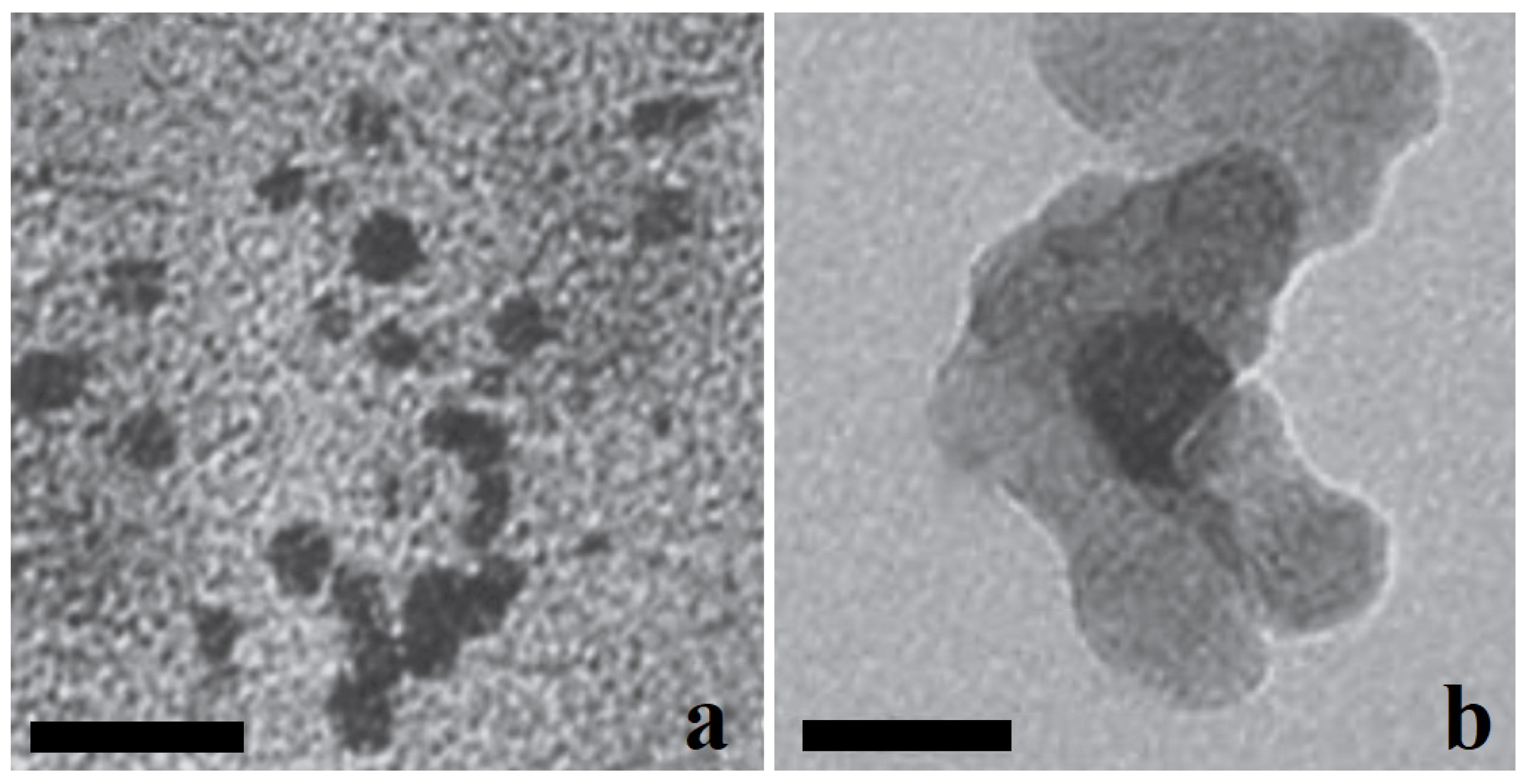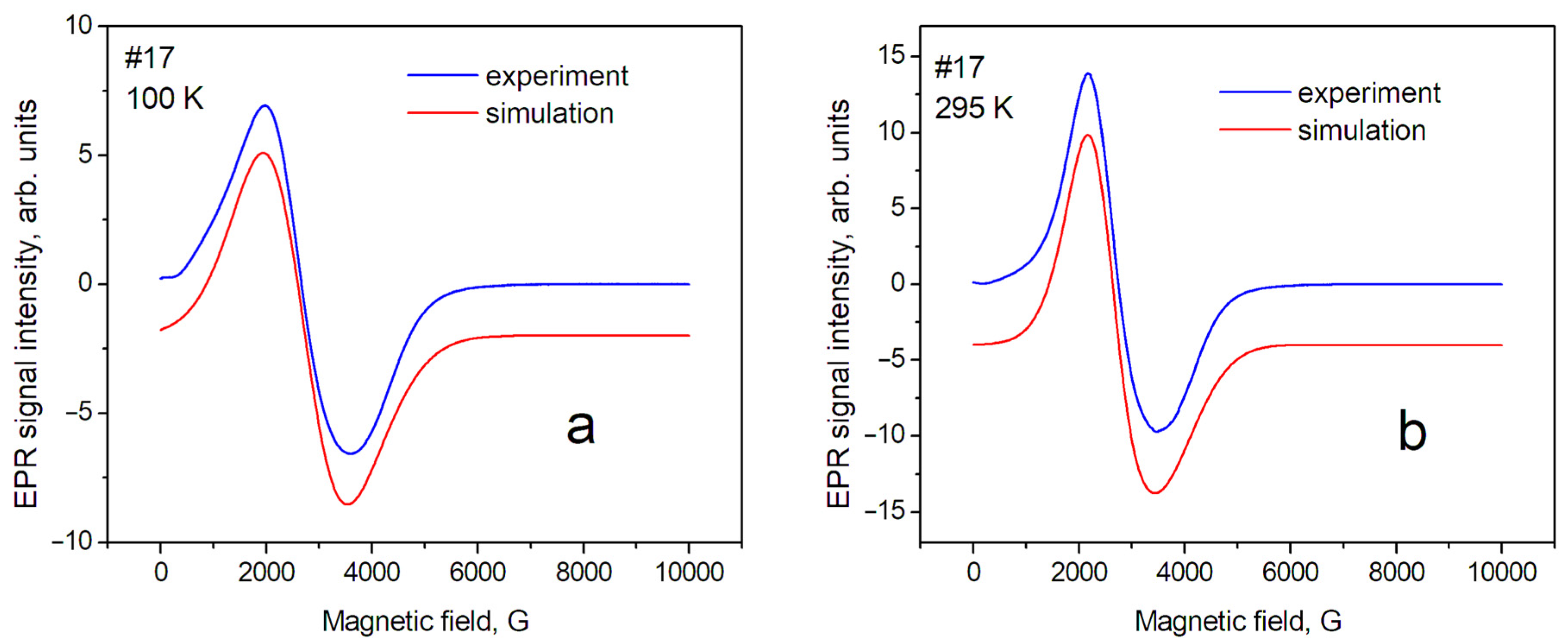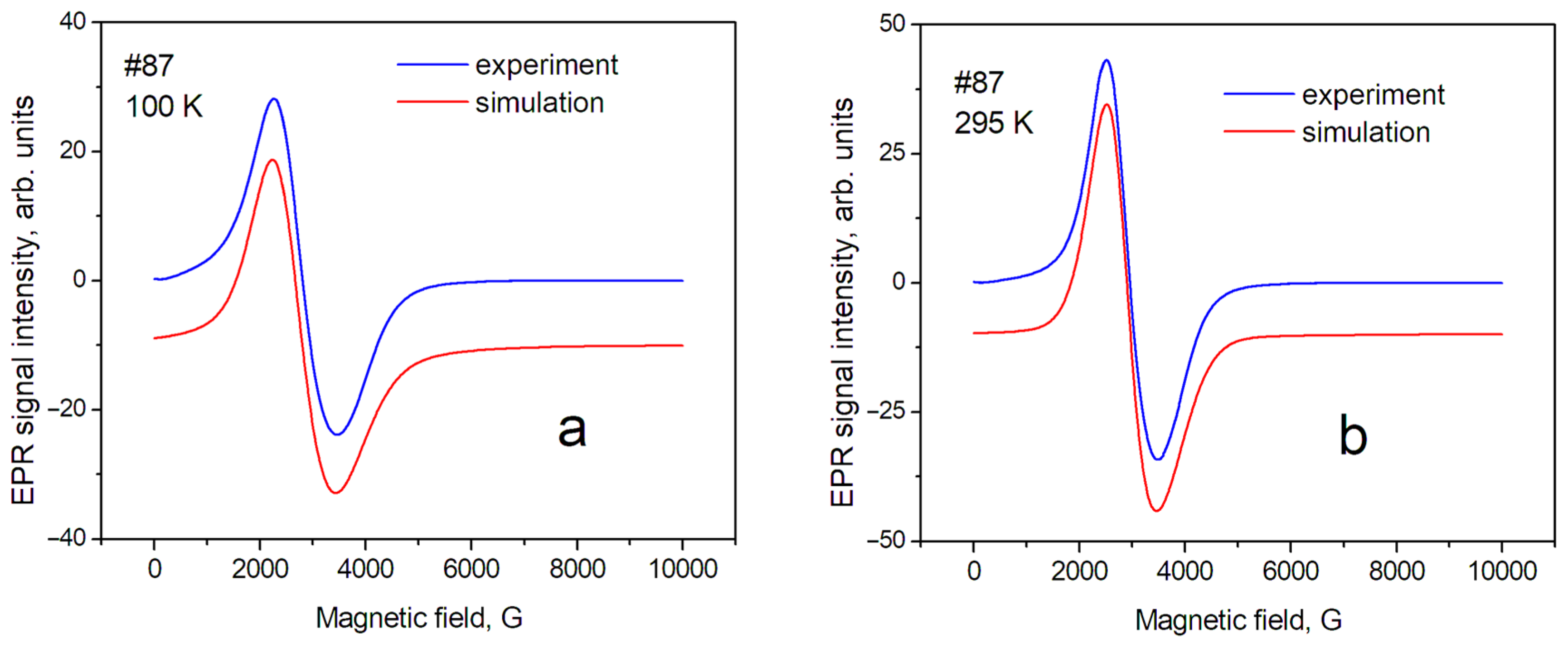Phase Composition and Magnetic Properties of Nanoparticles with Magnetite–Maghemite Structure
Abstract
1. Introduction
2. Materials and Methods
3. Results and Discussion
3.1. EPR Investigation of Magnetic Nanoparticles
3.2. Asymmetry of EPR Signal in Superparamagnets [32]
4. Conclusions
Author Contributions
Funding
Institutional Review Board Statement
Informed Consent Statement
Acknowledgments
Conflicts of Interest
References
- Peiffer, S. Book Review: The Iron Oxides von Rochelle M. Cornell und Udo Schwertmann. Acta Hydrochim. Hydrobiol. 2003, 31, 527. [Google Scholar] [CrossRef]
- Lyadov, A.S.; Kochubeev, A.A.; Koleva, L.D.; Parenago, O.P.; Khadzhiev, S.N. Synthesis of nanosized iron(III) oxide and study of its formation features. Russ. J. Inorg. Chem. 2016, 61, 1387–1391. [Google Scholar] [CrossRef]
- Laurent, S.; Boutry, S.; Muller, R.N. Chapter 1–Metal Oxide Particles and Their Prospects for Applications. In Iron Oxide Nanoparticles for Biomedical Applications; Mahmoudi, M., Laurent, S., Eds.; Elsevier: Amsterdam, The Netherlands, 2018; pp. 3–42. [Google Scholar] [CrossRef]
- Mamani, J.B.; Pavon, L.F.; Miyaki, L.A.; Sibov, T.T.; Rossan, F.; Silveira, P.H.; Zavala Cárdenas, W.H.; Amaro Junior, E.; Gamarra, L.F. Intracellular labeling and quantification process by magnetic resonance imaging using iron oxide magnetic nanoparticles in rat C6 glioma cell line. Einstein 2012, 10, 216–221. [Google Scholar] [CrossRef]
- Mamani, J.B.; Gamarra, L.F.; Brito, G.E.S. Synthesis and Characterization of Fe3O4 Nanoparticles with Perspectives in Biomedical Applications. Mater. Res. 2014, 17, 542–549. [Google Scholar] [CrossRef]
- Kokorin, A.I.; Kulyabko, L.S.; Degtyarev, E.N.; Kovarskii, A.L.; Patsaeva, S.V.; Dzhardimalieva, G.I.; Yurishcheva, A.A.; Kydralieva, K.A. Structure and Properties of Nanosized Composites Based on Fe3O4 and Humic Acids. Russ. J. Phys. Chem. B 2018, 12, 172–178. [Google Scholar] [CrossRef]
- Smith, C.A.; de la Fuente, J.; Pelaz, B.; Furlani, E.P.; Mullin, M.; Berry, C.C. The effect of static magnetic fields and tat peptides on cellular and nuclear uptake of magnetic nanoparticles. Biomaterials 2010, 31, 4392–4400. [Google Scholar] [CrossRef]
- Landázuri, N.; Tong, S.; Suo, J.; Joseph, G.; Weiss, D.; Sutcliffe, D.J.; Giddens, D.P.; Gang Bao Taylor, W.R. Magnetic Targeting of Human Mesenchymal Stem Cells with Internalized Superparamagnetic Iron Oxide Nanoparticles. Small 2013, 9, 4017–4026. [Google Scholar] [CrossRef] [PubMed]
- Yurtaeva, S.V.; Efimov, V.N.; Salnikov, V.V. EPR-spectroscopy of biogenic crystal iron oxides in biological tissues. In Proceedings of the Conference “Actual Questions of Biological Physics and Chemistry BFFH-17”, Sevastopol Crimea, Russia, 2–6 October 2017; pp. 361–365. (In Russian). [Google Scholar]
- Roushenas, P.; Yusop, Z.; Majidnia, Z.; Nasrollahpour, R. Photocatalytic degradation of spilled oil in sea water using maghemite nanoparticles. Desalination Water Treat. 2016, 57, 5837–5841. [Google Scholar] [CrossRef]
- Shilova, O.A.; Panova, G.; Nikolaev, A.; Kovalenko, A.; Sinelnikov, A.; Kopitsa, G.; Baranchikov, A.; Udalova, O.; Artemyeva, A.; Kornyuchin, D.; et al. Aqueous Chemical Co-Precipitation of Iron Oxide Magnetic Nanoparticles for Use in Agricultural Technologies. Lett. Appl. NanoBioSci. 2021, 10, 2215–2239. [Google Scholar] [CrossRef]
- Rahmatizadeh, R.; Arvin, S.M.J.; Jamei, R.; Mozaffari, H.; Nejhad, F.R. Response of tomato plants to interaction effects of magnetic (Fe3O4) nanoparticles and cadmium stress. J. Plant Interact. 2019, 14, 474–481. [Google Scholar] [CrossRef]
- Palmqvist, N.G.M.; Seisenbaeva, G.A.; Svedlindh, P.; Kessler, V.G. Maghemite Nanoparticles Acts as Nanozymes, Improving Growth and Abiotic Stress Tolerance in Brassica napus. Nanoscale Res. Lett. 2017, 12, 631. [Google Scholar] [CrossRef]
- Nikiforov, V.N.; Koksharov, Y.u.A.; Polyakov, S.N.; Malakho, A.P.; Volkov, A.V.; Moskvina, M.A.; Khomutov, G.B.; Irkhin, V.Y. Magnetism and Verwey transition in magnetite nanoparticles in thin polymer film. J. Alloys Compd. 2013, 569, 58–61. [Google Scholar] [CrossRef]
- Nikiforov, V.N.; Ignatenko, A.N.; Irkhin, V.Y. Size and Surface Effects on the Magnetism of Magnetite and Maghemite Nanoparticles. J. Exp. Theor. Phys. 2017, 124, 304–310. [Google Scholar] [CrossRef]
- Verwey, E.J.W.; Haayman, P.W. Electronic Conductivity and Transition Point of Magnetite («Fe3O4»). Physica 1941, 8, 979–987. [Google Scholar] [CrossRef]
- Nikiforov, V.N.; Goldt, A.E.; Gudilin, E.A.; Sredin, V.G.; Irhin, V.Y. Magnetic properties of maghemite nanoparticles. RAS Bull. Phys. Ser. 2014, 78, 1330–1335. (In Russian) [Google Scholar] [CrossRef]
- Liu, X.M.; Shaw, J.; Jiang, J.Z.; Bloemendal, J.; Hesse, P.; Rolph, T. X-G Analysis on variety and characteristics of maghemite. Sci. China Earth Sci. 2010, 53, 1153–1162. [Google Scholar] [CrossRef]
- Koksharov, Y.u.A.; Gubin, S.P.; Kosobudsky, I.D.; Yurkov GYu Pankratov, D.A.; Ponomarenko, L.A.; Mikheev, M.G.; Beltran, M.; Khodorkovsky, Y.; Tishin, A.M. Electron paramagnetic resonance spectra near the spin-glass transition in iron oxide nanoparticles. Phys. Rev. B 2000, 63, 012407. [Google Scholar] [CrossRef]
- Neelakanta, P.S. Handbook of Electromagnetic Materials: Monolithic and Composite Versions and Their Applications; CRC Press: Boca Raton, FL, USA; London, UK; New York, NY, USA; Washington, DC, USA, 1995. [Google Scholar]
- Sohrabijam, Z.; Zamanian, A.; Saidifar, M.; Nouri, A. Prepartion and Characterization of Superparamagnetic Chitosan Coated Maghemite (γ-Fe2O3) for Gene Delivery. Procedia Mater. Sci. 2015, 11, 282–286. [Google Scholar] [CrossRef]
- Nasrazadani, S.; Raman, A. The application of infrared spectroscopy to the study of rust systems—II. Study of cation deficiency in magnetite (Fe3O4) produced during its transformation to maghemite (γ-Fe2O3) and hematite (α-Fe2O3). Corros. Sci. 1993, 34, 1355–1365. [Google Scholar] [CrossRef]
- Cervellino, A.; Frison, R.; Cernuto, G.; Guagliardi, A.; Masciocchi, N. Lattice parameters and site occupancy factors of magnetite–maghemite core–shell nanoparticles. A critical study. J. Appl. Cryst. 2014, 47, 1755–1761. [Google Scholar] [CrossRef]
- Winsett, J.; Moilanen, A.; Paudel, K.; Kamali, S.; Ding, K.; Cribb, W.; Seifu, D.; Neupane, S. Quantitative determination of magnetite and maghemite in iron oxide nanoparticles using Mössbauer spectroscopy. SN Appl. Sci. 2019, 1, 1636. [Google Scholar] [CrossRef]
- Dehsari, H.S.; Ksenofontov, V.; Möller, A.; Jakob, G.; Asadi, K. Determining Magnetite/Maghemite Composition and Core–Shell Nanostructure from Magnetization Curve for Iron Oxide Nanoparticles. J. Phys. Chem. C 2018, 122, 28292–28301. [Google Scholar] [CrossRef]
- Baabu, P.R.S.; Kumar, H.K.; Gumpu, M.B.; Babu, J.; Kulandaisamy, A.J.; Rayappan, J.B.B. Iron Oxide Nanoparticles: A Review on the Province of Its Compounds, Properties and Biological Applications. Materials 2023, 16, 59. [Google Scholar] [CrossRef] [PubMed]
- Shilova, O.A.; Nikolaev, A.M.; Kovalenko, A.S.; Sinel’nikov, A.A.; Kopitsa, G.P.; Baranchikov, A.E. Synthesis of Magnetic Nanopowders of Iron Oxide: Magnetite and Maghemite. Russ. J. Inorg. Chem. 2020, 65, 426–430. [Google Scholar] [CrossRef]
- Darezereshki, E. Synthesis of maghemite (γ-Fe2O3) nanoparticles by wet chemical method at room temperature. Mater. Lett. 2010, 64, 1471. [Google Scholar] [CrossRef]
- Liu, S.; Wu, G.; Chen, H.; Wang, M. Preparation and characterization of Fe3O4/SiO2 particles for dual-particle electrophoretic display. Synth. Met. 2012, 162, 89. [Google Scholar] [CrossRef]
- Pecharroman, C.; Gonzalez-Carreno, T.; Iglesias, J.E. Phys. The infrared dielectric properties of maghemite, γ-Fe2O3, from reflectance measurement on pressed powders. Chem. Miner. 1995, 22, 21. [Google Scholar] [CrossRef]
- Anthony, J.W.; Bideaux, R.A.; Bladh, K.W. Magnetite. In Handbook of Mineralogy; Mineralogical Society of America: Chantilly, VA, USA, 2018; 333p. [Google Scholar]
- Shanina, B.D.; Konchits, A.A.; Krasnovyd, S.V.; Shevchenko Yu, B.; Petranovs’ka, A.L.; Rieznichenko, L.S. Magnetic nanoparticle ensembles with promising biophysical applications: An EPR study. J. Appl. Phys. 2022, 132, 163905. [Google Scholar] [CrossRef]
- Crouch, G.E. Ferromagnetic resonance in iron oxides. Phys. Rev. 1949, 75, 525. [Google Scholar] [CrossRef]
- Kliava, J.; Berger, R. Size and shape distribution of magnetic nanoparticles in disordered systems: Computer simulations of superparamagnetic resonance spectra. J. Magn. Magn. Mater. 1999, 205, 328–342. [Google Scholar] [CrossRef]
- Shahane, G.S.; Zipare, K.V.; Pant, R.P. Synthesis and characterization of superparamagnetic Fe3O4 nanoparticles for ferrofluid application. Magnetohydrodynamics 2013, 49, 317–321. [Google Scholar] [CrossRef]
- Abragam, A.; Bleaney, B. Electron Paramagnetic Resonance of Transition Ions; Clarendon: Oxford, UK, 1970. [Google Scholar]
- Waltz, F. The Verwey transition—A topical review. J. Phys. Cond. Matter. 2002, 14, R285. [Google Scholar] [CrossRef]
- Misra, S.K.; Andronenko, S.I.; Tipikin, D.; Freed, J.H.; Somani, V. Om Prakash Study of paramagnetic defect centers in as-grown and annealed TiO2 anatase and rutile nanoparticles by a variable-temperature X-band and high-frequency (236 GHz) EPR. JMMM 2016, 401, 495–505. [Google Scholar] [CrossRef] [PubMed]
- Andronenko, S.I.; Misra, S.K. A review of EPR investigations of nanoparticles of dilute magnetic semiconductors doped by transition metal ions. Appl. Magn. Reson. 2015, 46, 693–707. [Google Scholar] [CrossRef]




| Sample | a, Å | DCSD, nm |
|---|---|---|
| Maghemite γ-Fe2O3 [22,30] | 8.336–8.339 | - |
| γ-Fe2O3 (№ 87) | 8.341 (4) | 14 |
| Fe3O4-γ-Fe2O3 (№ 17) | 8.355 (4) | 19 |
| Magnetite Fe3O4 [22,31] | 8.396–8.397 | - |
| Sample | T | gx | gy | gz | |||
|---|---|---|---|---|---|---|---|
| #17 Fe3O4 | 295 K | 2.17 | 2.17 | 2.70 | 800 | 800 | 330 |
| 100 K | 2.35 | 2.35 | 2.60 | 1000 | 1000 | 550 | |
| #87 g- Fe2O3 | 295 K | 2.12 | 2.12 | 2.42 | 600 | 600 | 270 |
| 100 K | 2.17 | 2.17 | 2.70 | 650 | 650 | 350 |
Disclaimer/Publisher’s Note: The statements, opinions and data contained in all publications are solely those of the individual author(s) and contributor(s) and not of MDPI and/or the editor(s). MDPI and/or the editor(s) disclaim responsibility for any injury to people or property resulting from any ideas, methods, instructions or products referred to in the content. |
© 2023 by the authors. Licensee MDPI, Basel, Switzerland. This article is an open access article distributed under the terms and conditions of the Creative Commons Attribution (CC BY) license (https://creativecommons.org/licenses/by/4.0/).
Share and Cite
Andronenko, S.I.; Nikolaev, A.M.; Suharzhevsky, S.M.; Sinelnikov, A.A.; Kovalenko, A.S.; Ivanova, A.G.; Shilova, O.A. Phase Composition and Magnetic Properties of Nanoparticles with Magnetite–Maghemite Structure. Ceramics 2023, 6, 1623-1631. https://doi.org/10.3390/ceramics6030099
Andronenko SI, Nikolaev AM, Suharzhevsky SM, Sinelnikov AA, Kovalenko AS, Ivanova AG, Shilova OA. Phase Composition and Magnetic Properties of Nanoparticles with Magnetite–Maghemite Structure. Ceramics. 2023; 6(3):1623-1631. https://doi.org/10.3390/ceramics6030099
Chicago/Turabian StyleAndronenko, Sergey I., Anton M. Nikolaev, Stanislav M. Suharzhevsky, Alexander A. Sinelnikov, Anastasia S. Kovalenko, Alexandra G. Ivanova, and Olga A. Shilova. 2023. "Phase Composition and Magnetic Properties of Nanoparticles with Magnetite–Maghemite Structure" Ceramics 6, no. 3: 1623-1631. https://doi.org/10.3390/ceramics6030099
APA StyleAndronenko, S. I., Nikolaev, A. M., Suharzhevsky, S. M., Sinelnikov, A. A., Kovalenko, A. S., Ivanova, A. G., & Shilova, O. A. (2023). Phase Composition and Magnetic Properties of Nanoparticles with Magnetite–Maghemite Structure. Ceramics, 6(3), 1623-1631. https://doi.org/10.3390/ceramics6030099







